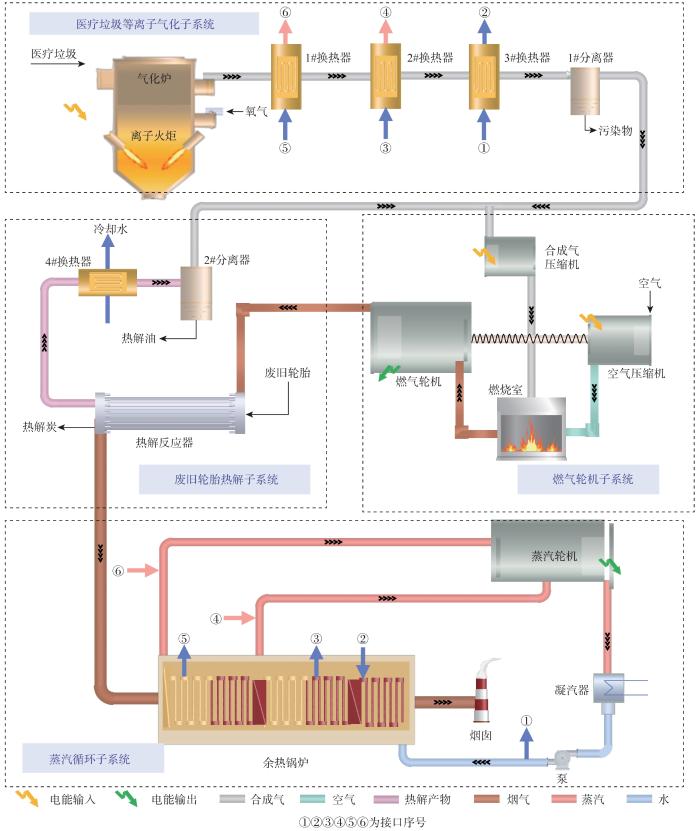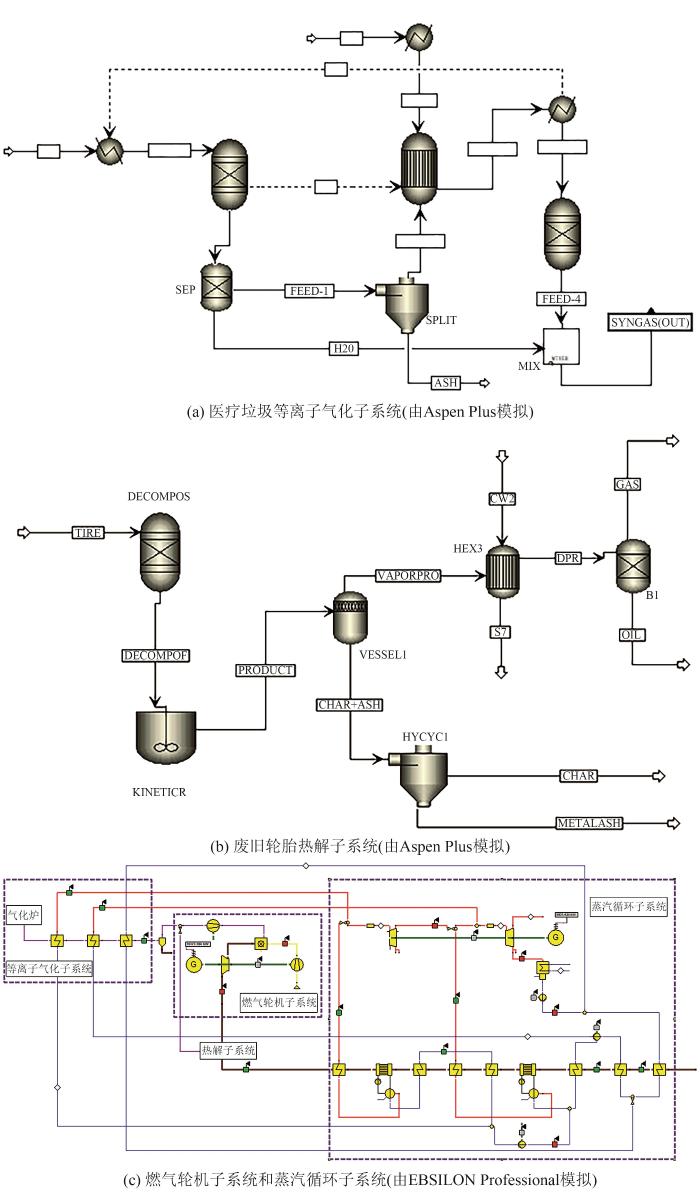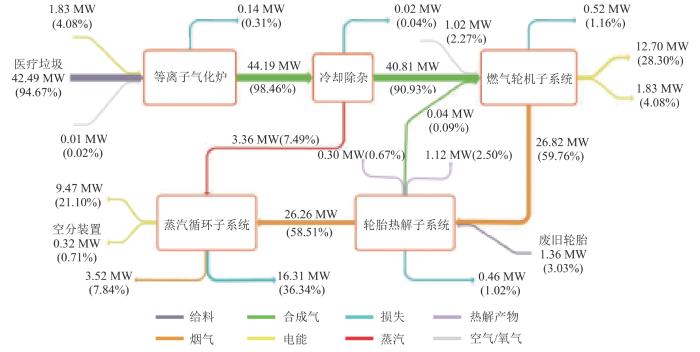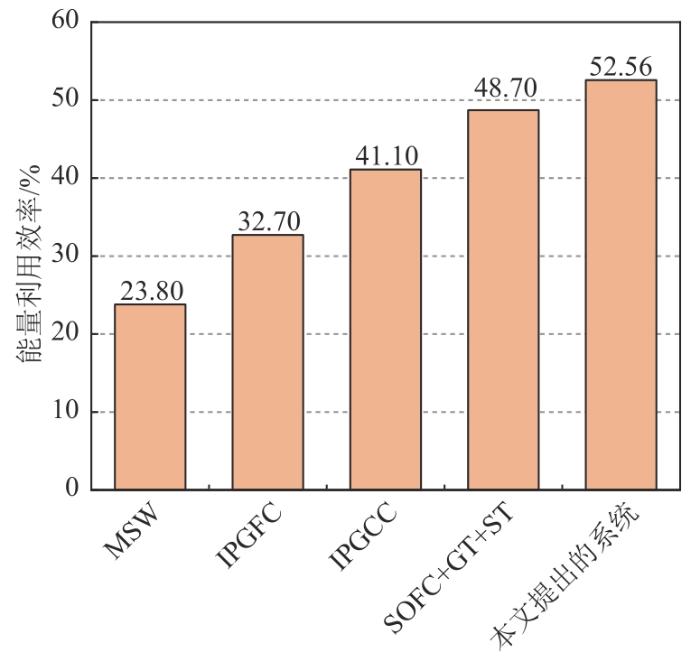0 引言
在新型冠状病毒肺炎全球大流行期间,医疗垃圾急剧增加,这不仅给环境造成了巨大压力,也给城市医疗废物管理带来了新的挑战。医疗废物是指在病人诊断、治疗、护理等活动过程中产生的废物,其中含有大量的病原微生物和有害的化学物质[1]。医疗废物处理不当会引起疾病的传播以及相关的公共卫生问题,而能源回收正是废物管理的有效方法之一。
国内外学者对基于等离子气化的电力系统开展了大量研究。Mazzoni等[11]评估了采用等离子体气化方式从城市固体废物(municipal solid waste,MSW)焚烧厂中回收能量的可行性,在Aspen Plus环境中建立了集成等离子体气化联合循环(integrated plasma gasification combined cycle,IPGCC)的电厂模型,并研究了不同成分气化剂对合成气的影响。Owebor等[12]提出了一个由气化系统、固体氧化物燃料电池(solid oxide fuel cell,SOFC)、燃气轮机、蒸汽轮机、有机朗肯循环和吸收式制冷循环组成的固体废物能源转换系统,并对该系统进行了热力学分析、环境分析和经济性分析。Bellomare等[13]研究了一个集成SOFC和GT的城市固体废物气化厂,结果表明,在优化配置下,该气化厂的效率高达52%,且废气中不含有害污染物。Paulino等[14]设计并分析了一套由等离子气化炉和内燃机组成的热电联产系统,研究结果表明,该系统的气化效率高达78.58%,发电效率约为31%,预计的资本回收周期为6年。
尽管基于气化的动力系统具有很大的优势,但关于将轮胎热解装置集成到基于气化的动力系统中,以生产其他有用商品的研究鲜见报道。基于以上背景,本文提出了一种基于气化和热解的医疗垃圾-废旧轮胎联合资源化利用系统,在医疗垃圾-废旧轮胎无害化处理的同时,实现固废能质的梯级利用,此类系统有望为清洁、高效地利用固体废物资源提供一种新的可能性。
1 系统组成
基于气化和热解的医疗垃圾-废旧轮胎联合资源化利用系统由医疗垃圾等离子气化子系统、废旧轮胎热解子系统、燃气轮机子系统和蒸汽循环子系统4个主要部分组成,如图1所示。
图1
图1
基于气化和热解的医疗垃圾-废旧轮胎联合资源化利用系统示意图
Fig. 1
Diagram of combined medical waste-waste tire resource utilization system based on gasification and pyrolysis
医疗垃圾进入气化炉并转化为粗合成气,然后利用换热器和分离器冷却高温合成气并进行净化。同时,预处理后的轮胎被供应给热解反应器,热解炭从热解反应器底部析出,热解油和热解气在4#换热器中冷却后被分离。随后,气化合成气和热解合成气混合后被送至燃气轮机子系统。
在燃气轮机子系统中,清洁的合成气被合成气压缩机压缩后进入燃烧室,空气被空气压缩机压缩后进入燃烧室,燃料的化学能通过燃烧释放并转化为烟气的热能,随后,高温烟气进入燃气轮机中膨胀做功,产生电能。燃气轮机出口的烟气首先为轮胎热解子系统提供热源,这减少了该系统额外的热量输入,之后流经双压余热锅炉进行热量回收。
2 系统建模及评价指标
2.1 仿真模型
图2
图2
基于气化和热解的医疗垃圾-废旧轮胎联合资源化利用系统仿真模型
Fig. 2
Simulation models for combined medical waste-waste tire resource utilization system based on gasification and pyrolysis
基于新系统,在建模和分析过程中进行以下假设:1)系统在稳态条件下工作;2)系统内动能和势能的变化忽略不计;3)合成气压缩机、空气压缩机、燃气轮机、蒸汽轮机和泵的等熵效率分别为85%、85%、90%、90%和80%[19];4)环境温度和压力分别为25.0 ℃和101.325 kPa。
2.2 能量评价指标
冷气效率被用来评估等离子气化器的性能,计算公式如下:
式中:msyn为合成气流量,kg/s;
系统的总能量输出效率计算公式如下:
式中:
2.3 经济性评价指标
采用传统净现值(net present value,NPV)和动态投资回收期(dynamic payback period,DPP)评估新系统的经济性。当净收入等于总投资时,DPP值越小,资本回收周期越快。具体计算公式如下:
式中:
3 仿真结果与分析
3.1 系统性能参数
3.1.1 等离子气化子系统
表1 典型医疗垃圾的物性参数
Tab. 1
| 参数 | 数值 | |
|---|---|---|
| 工业分析 | 水分质量分数/% | 0.32 |
| 固定碳质量分数/% | 0.55 | |
| 挥发分质量分数/% | 99.13 | |
| 灰分质量分数/% | 0.00 | |
| 元素分析 | 碳质量分数/% | 81.55 |
| 氢质量分数/% | 12.13 | |
| 氧质量分数/% | 5.74 | |
| 氮质量分数/% | 0.15 | |
| 硫质量分数/% | 0.11 | |
| 低位发热量/(MJ⋅kg-1) | 42.49 | |
表2 等离子气化炉的参数
Tab. 2
| 项目 | 数值 |
|---|---|
| 医疗垃圾进料量/(kg⋅s-1) | 1.00 |
| 氧气进口流量/(kg⋅s-1) | 0.34 |
| 氧气进口温度/℃ | 25.00 |
| 合成气出口流量/(kg⋅s-1) | 1.34 |
| 合成气出口温度/℃ | 1 105.14 |
| 等离子体火炬热功率% | 85 |
| 等离子体火炬耗功/kW | 1 830 |
| 空分耗功/kW | 340 |
| 冷气效率/% | 82.04 |
表3 等离子气化炉出口合成气的参数
Tab. 3
| 参数 | 数值 | |
|---|---|---|
| 合成气组成成分 | H2摩尔分数/% | 24.29 |
| CO摩尔分数/% | 35.04 | |
| CH4摩尔分数/% | 20.08 | |
| H2O摩尔分数/% | 0.20 | |
| N2摩尔分数/% | 0.01 | |
| H2S摩尔分数/% | 0.05 | |
| HCN摩尔分数/% | 0.14 | |
| 低位发热量/(MJ⋅kg方正汇总行-1) | 30.40 | |
医疗垃圾以1 kg/s的固定速率进入气化炉,在与气化剂(0.34 kg/s的纯氧)混合后发生反应。气化炉出口产生的合成气流量为1.34 kg/s,其主要成分为H2、CO和CH4,原始合成气的低位发热量为30.40 MJ/kg。在等离子体火炬消耗1.83 MW电能的情况下,气化炉冷气效率可达到82.04%。气化炉出口合成气具有较高的温度,需经过冷却和净化后才可作为燃气轮机燃料使用。
3.1.2 轮胎热解子系统
表4 废旧轮胎的物性参数
Tab. 4
| 参数 | 数值 | |
|---|---|---|
| 工业分析 | 水分质量分数/% | 1.50 |
| 固定碳质量分数/% | 30.00 | |
| 挥发分质量分数/% | 55.00 | |
| 灰分质量分数/% | 13.50 | |
| 元素分析 | 碳质量分数/% | 75.00 |
| 氢质量分数/% | 7.00 | |
| 氧质量分数/% | 2.70 | |
| 氮质量分数/% | 0.30 | |
| 低位发热量/(MJ⋅kg-1) | 34.38 | |
轮胎热解子系统的参数如表5所示。废旧轮胎以0.042 3 kg/s的进料速率进入热解反应器后发生一系列化学反应,产生合成气、热解油和热解炭,随后,来自热解反应器的高温蒸汽产品在换热器中被冷却到40 ℃。热解油含有100多种成分,并且可以出售;热解合成气和气化产生的合成气混合后,一同进入燃气轮机子系统。
表5 轮胎热解子系统的参数
Tab. 5
| 参数 | 数值 |
|---|---|
| 热解反应器的温度/℃ | 580.00 |
| 轮胎进料量/(kg⋅s-1) | 0.042 3 |
| 热解产物的冷却温度/℃ | 40.00 |
| 热解合成气的流量/(kg⋅s-1) | 0.002 2 |
| 热解油的流量/(kg⋅s-1) | 0.026 1 |
| 热解炭的流量/(kg⋅s-1) | 0.008 3 |
3.1.3 燃气轮机子系统
由气化和热解产生的合成气混合后被输送到燃气轮机子系统。燃气轮机子系统的参数如表6所示。1.34 kg/s的合成气被压缩到1.69 MPa,与40.74 kg/s的加压空气一起进入燃烧室,参与燃烧反应。燃烧室出口产生42.08 kg/s的烟气,温度高达1 249.51 ℃,经过燃气轮机膨胀做功后,烟气温度降至591.70 ℃,随后进入热解反应器,为轮胎热解子系统提供热量。
表6 燃气轮机子系统的参数
Tab. 6
| 参数 | 数值 |
|---|---|
| 空气进气温度/℃ | 25.00 |
| 空气进气压力/MPa | 0.10 |
| 空气进气流量/(kg⋅s-1) | 40.74 |
| 空气压缩机的机械效率/% | 99.00 |
| 燃烧室进口压力/MPa | 1.69 |
| 燃烧室出口温度/℃ | 1 249.51 |
| 燃气轮机机械效率/% | 99.00 |
| 燃气轮机出口温度/℃ | 591.70 |
3.1.4 蒸汽循环子系统
表7 蒸汽循环子系统的参数
Tab. 7
| 参数 | 数值 |
|---|---|
| 高(中)压蒸汽温度/℃ | 543.0(258.0) |
| 高(中)压蒸汽压力/MPa | 12.40(1.03) |
| 高(中)压汽轮机等熵效率/% | 90.0(90.0) |
| 高(中)压汽轮机机械效率/% | 99.0(99.0) |
| 凝汽器压力/MPa | 0.004 8 |
3.2 能量分析
在进料量不变的条件下,对集成系统进行能量分析,结果如表8所示。集成系统输出总能量为25.74 MW,其中热解子系统输出1.42 MW,其余能量以电能形式输出,包括2部分:燃气轮机输出14.53 MW;蒸汽轮机输出9.79 MW。考虑等离子体火炬和空分装置消耗的额外电能,系统输出净总能量为23.59 MW,总能量效率为52.56%。
表8 集成系统的能量分析
Tab. 8
| 参数 | 数值 |
|---|---|
| 医疗垃圾进料量/(kg⋅s-1) | 1.00 |
| 气化剂(氧气)流量/(kg⋅s-1) | 0.34 |
| 轮胎进料量/(kg⋅s-1) | 0.04 |
| 热解子系统输出的能量/MW | 1.42 |
| 系统输出的电能/MW | 24.32 |
| 等离子体火炬耗功/MW | 1.83 |
| 空分装置耗功/MW | 0.32 |
| 系统输出的净总能量/MW | 23.59 |
| 系统的总能量输出效率/% | 52.56 |
为了进一步说明集成系统的能量利用和转化机理,绘制了该系统的能流图,如图3所示。输入系统的总能量为100%,等离子体火炬消耗1.83 MW电能的同时,气化炉产生的合成气能量为44.19 MW,经冷却除杂后,40.81 MW清洁的合成气进入燃气轮机子系统,同时,3.36 MW的热量由换热器从高温合成气中回收。含1.02 MW能量的空气被压缩后参与燃烧反应,不包含等离子体火炬消耗的功率,燃气轮机输出的电能为12.70 MW,随后,26.82 MW的烟气热量伴随着含有1.36 MW能量的轮胎被输送到热解子系统。热解子系统利用高温烟气的一部分热量后,剩余26.26 MW热量的烟气被输入到蒸汽循环子系统,该子系统在输出电能的同时,通过废气输送给周围环境3.52 MW(7.84%)的热量,凝汽器损失16.31 MW的热量,占总能量输入的36.34%,是系统中能量损失最大的部位。
图3
图4
3.3 经济性分析
表9 经济性分析相关参数
Tab. 9
| 参数 | 数值 |
|---|---|
| 生命周期/a | 20 |
| 建设周期/a | 1 |
| 年运行时间/h | 7 000 |
| 医疗垃圾处理补贴/(元/t) | 3 080.03 |
| 玻璃样渣的价格/(元/t) | 357.10 |
| 热解油的价格/(元/t) | 776.88 |
| 热解炭的价格/(元/t) | 471.44 |
| 上网电价/[元/(kW⋅h)] | 0.65 |
| 运行成本/万元 | 10%总投资 |
| 贴现率/% | 10 |
| 人民币对美元汇率 | 6.64 |
表10 基于经验公式法的成本估算
Tab. 10
表11 基于规模因子法的成本估算
Tab. 11
新系统中各组成部分的投资成本如表12所示。该系统的总投资为27 791.07万元,等离子气化系统投资占比最大,为总投资的45.36%,燃气轮机子系统和蒸汽循环子系统的投资分别占总投资的27.54%和25.24%。
表12 新系统中各组成部分的投资成本
Tab. 12
| 组成 | 投资成本/万元 | |
|---|---|---|
| 等离子气化子系统 | 气化炉 | 4 720.39 |
| 等离子体火炬 | 350.63 | |
| 1#、2#、3#换热器 | 97.98 | |
| 1#分离器 | 3 603.28 | |
| 空分装置 | 3 833.84 | |
| 合计 | 12 606.12 | |
| 热解子系统 | 热解反应器 | 515.72 |
| 4#换热器 | 3.02 | |
| 合计 | 518.74 | |
| 燃气轮机子系统 | 合成气压缩机 | 8.92 |
| 空气压缩机 | 710.38 | |
| 燃烧室 | 53.54 | |
| 燃气轮机 | 6 505.89 | |
| 发电机 | 373.64 | |
| 合计 | 7 652.37 | |
| 蒸汽循环子系统 | 余热锅炉 | 3 534.67 |
| 蒸汽轮机 | 3 070.76 | |
| 凝汽器 | 116.36 | |
| 泵 | 45.42 | |
| 发电机 | 246.63 | |
| 合计 | 7 013.84 | |
| 总计 | 27 791.07 | |
新系统的经济性分析结果如表13所示。在运营期间,集成系统的年总收入为17 927.25万元,远高于年运营成本2 779.10万元。假设贴现率为10%,动态回收周期的计算结果表明,完成资本回收的时间仅为3.13年。在经济性分析的20年期限内,系统净现值达到72 797.81万元。由此可见,新系统的经济性是相当突出的。
表13 新系统的经济性分析结果
Tab. 13
| 参数 | 数值 |
|---|---|
| 年净发电量/(MW⋅h) | 155 152.26 |
| 年炉渣产量/t | 4 536.00 |
| 年净发电收入/万元 | 9 942.57 |
| 年垃圾处理补贴/万元 | 7 761.68 |
| 年炉渣销售收入/万元 | 161.98 |
| 年热解油销售收入/万元 | 51.16 |
| 年热解炭销售收入/万元 | 9.86 |
| 年总收入/万元 | 17 927.25 |
| 总投资成本/万元 | 27 791.07 |
| 年运营成本/万元 | 2 779.10 |
| 动态回收周期/年 | 3.13 |
| 净现值/万元 | 72 797.81 |
4 结论
提出了一种基于医疗垃圾等离子气化和轮胎热解的新型多联产系统,利用能量分析法和经济性分析法对新系统进行了综合评估,得出以下结论:
1)当原料进料量保持不变时,新系统输出的总能量为23.59 MW,电能占93.98%,热解油和热解炭分别占4.75%和1.27%。
2)新系统的总能量效率为52.56%,这是因为以高温烟气为热源的热解装置,使烟气热量得到了充分利用,实现了炭油电的联合生产。因此,与其他垃圾发电/集成系统相比,新系统具有较高的能量利用效率。
3)新系统的动态投资回收期仅为3.13年,在20年的寿命期内可实现相对净现值72 797.81万元,具有较好的经济性。
4)要想实现工业上的应用,还需要考虑实际排气温度与热解温度的温差,轴封漏气、烟气系统环保设施的流动阻力和引风机功耗等对系统的影响。
参考文献
医疗废物处理处置污染控制标准解读
[J].
Interpretation of standard for pollution control on medical waste treatment and disposal
[J].
Chemical looping reforming of toluene as a biomass tar model compound over two types of oxygen carriers:2CuO-2NiO/Al2O3 and CaFe2O4
[J].
生物质与生活垃圾共气化过程重金属的迁移转化规律
[J].
Migration and transformation of heavy metals in the co-gasification of biomass and municipal waste
[J].
Pre-treatment and utilisation of municipal solid waste incineration bottom ashes towards a circular economy
[J].
Addressing environmental sustainability of plasma vitrification technology for stabilization of municipal solid waste incineration fly ash
[J].
国内外生活垃圾焚烧发电技术进展
[J].
An overview of power generation from municipal solid waste incineration plants at home and abroad
[J].
Effect of origin and production rate of MSW on the exergoeconomic performance of an integrated plasma gasification combined cycle power plant
[J].
Environmental sustainability assessment of land disposal of municipal solid waste generated in Indian cities:a review
[J].
生物质气化耦合发电体系的合成气组分与能量分析
[J].
Analysis of syngas components and energy in biomass gasification coupled power generation system
[J].
Plasma gasification of two waste streams:municipal solid waste and hazardous waste from the oil and gas industry
[J].
Plasma gasification of municipal solid waste with variable content of plastic solid waste for enhanced energy recovery
[J].
Thermo-environmental and economic analysis of an integrated municipal waste-to-energy solid oxide fuel cell,gas-,steam-,organic fluid- and absorption refrigeration cycle thermal power plants
[J].
Integration of a municipal solid waste gasification plant with solid oxide fuel cell and gas turbine
[J].
The use of syngas from biomedical waste plasma gasification systems for electricity production in internal combustion:thermodynamic and economic issues
[J].
废旧轮胎的资源化与无害化技术现状与研究
[J].
Current situation and research on recycling and harmless technology of waste tire
[J].
Thermodynamic comparison of pyrolysis and gasification of waste tyres
[J].
基于ASPEN Plus的村镇垃圾热解气化燃烧模拟与试验
[D].
Simulation and experiment of pyrolysis,gasification and combustion of village waste based on aspen plus
[D].
直接空冷乏汽提质供热系统变工况特性研究
[J].
A study on variable operating characteristics of a direct air-cooling exhaust steam extraction heat supply system
[J].
Evaluation of power and freshwater production based on integrated gas turbine,S-CO2,and ORC cycles with RO desalination unit
[J].
Plasma gasification of the medical waste
[J].
Modelling and performance analysis of an integrated plasma gasification combined cycle (IPGCC) power plant
[J].
Pyrolysis of waste tires:a modeling and parameter estimation study using Aspen Plus®
[J].
Exergetic and economic evaluation of the effect of HRSG configurations on the performance of combined cycle power plants
[J].
Exergy analysis of municipal solid waste incineration processes:the use of O
From waste to electricity through integrated plasma gasification/fuel cell (IPGFC) system
[J].
Modelling and performance analysis of an integrated plasma gasification combined cycle (IPGCC) power plant
[J].
Design and eco-technoeconomic analyses of SOFC/GT hybrid systems accounting for long-term degradation effects
[J].
A techno-economic-environmental study evaluating the potential of oxygen-steam biomass gasification for the generation of value-added products
[J].
Techno-economic assessment of a conceptual waste-to-energy CHP system combining plasma gasification,SOFC,gas turbine and supercritical CO2 cycle
[J].
Performance assessment of a novel medical-waste-to-energy design based on plasma gasification and integrated with a municipal solid waste incineration plant
[J].
Simulation and techno-economic assessment of bio-methanol production from pine biomass,biochar and pyrolysis oil
[J].
基于医疗垃圾等离子气化的零碳高效热电联产系统性能分析
[J].
Performance assessment of a zero-carbon emission waste-to-energy CHP hybrid system based on plasma gasification
[J].
CO2 capture from syngas generated by a biomass gasification power plant with chemical absorption process
[J].
Effect of origin and production rate of MSW on the exergoeconomic performance of an integrated plasma gasification combined cycle power plant
[J].
Exergy,economic and environmental impact assessment and optimization of a novel cogeneration system including a gas turbine,a supercritical CO2 and an organic Rankine cycle (GT-HRSG/SCO2)
[J].
Techno-economic-environmental analysis of coal-based methanol and power poly-generation system integrated with biomass co-gasification and solar based hydrogen addition
[J].









